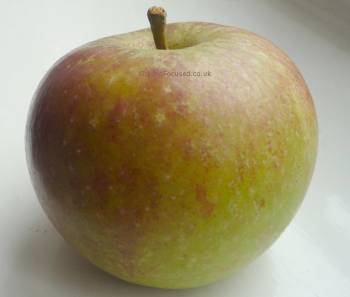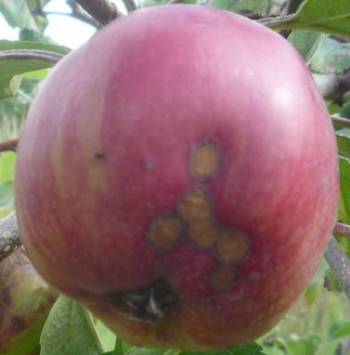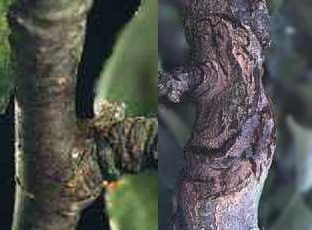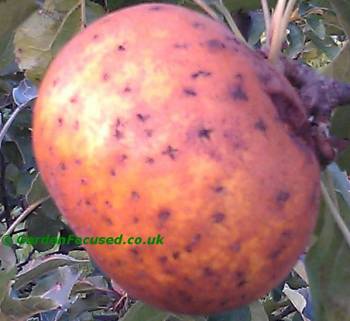HISTORY OF COX’S ORANGE PIPPIN
The parents of Cox’s Orange Pippin have never been confirmed however one parent is likely to have been Ribston Pippin and there is good reason to believe the other parent may have been Blenheim Orange. It was bred by Richard Cox sometime around 1825 in Colnbrook, Berkshire. The original house, The Lawns, was knocked down many years ago and is now under the foundations of a High Street in Slough.
The original tree was then propagated by a local nurseryman (E. Small & Son) on his market garden. They attempted to market the trees in the early 1840s with only minimal success. In 1950 however, another local firm in Slough, Royal Nurseries marketed the trees with much more success.
The first large scale marketing of Cox’s Orange Pippin began in 1862 and continued until the very early 1900s. Unfortunately this variety of apple is prone to canker, scab and several other apple diseases and in the absence of effective pest and disease control methods commercial production virtually ceased. In the mid 1920s better (massive chemical spraying!) methods were devised and the Cox’s Orange Pippin gradually increased in popularity once again.
In the early 1990s a self-fertile sport of Cox’s Orange Pippin was introduced which in all other respects remains identical to the original.
Up until 2012, commercially it was the most popular apple variety to be sold in the UK. Now though it has just been pipped (pun intended) by the variety Gala. Unfortunately, although Cox’s Orange Pippin undeniably tastes better, the keeping qualities, disease resistance and growing capabilities of varieties such as Gala are slowly winning the supermarkets over.
Because of its excellent taste and texture Cox’s Orange Pippin is the parent of many other varieties, for a full list click here. Notable amongst the list is Rubinette which has a taste very close to its parent but unfortunately also suffers from many of its drawbacks. Of the more modern varieties Fiesta has a similar taste, keeps longer and has better disease resistance.
APPEARANCE, TASTE AND CHARACTERISTICS OF COX’S ORANGE PIPPIN
As far as looks go this variety is a rather small apple with a base colour of green and yellow and lots of red and orange overlaid. In our experience it tends to redden up the longer it stays on the tree.
Taste is always a personal opinion and in our opinion this is definitely one of the best tasting apples in the world. Many others have the same view although it is a reasonably adult taste with acidity as well as sweetness, children and those with a sweet tooth might prefer an apple with less acidity.
The texture is most definitely a very pleasing crunchy one and when bitten into the amount of apple juice is just right. Without going into silly wine tasting descriptions of the aroma, let’s just say that we’ve never heard anyone do anything but compliment this apple. Fresh and fruity is how we would describe the aroma.
So this is a top class eating apple but don’t forget that it also cooks well. It won’t puree down to a paste like a Bramley does but if you plan to use it for chutney, a chunky apple pie or a crumble then it’s excellent. Because it is already sweeter than many cookers just don’t add too much additional sugar.
The comments above may lead you to believe that this is the best eating apple in the world but a Cox’s Orange Pippin apple tree has its fair share of faults. The number one problem is that its disease resistance is low and it is affected by all the common apple tree problems including canker, scab and aphids to a larger degree than many other varieties. It’s not suited at all to wetter areas of the UK, you will almost certainly face a losing battle if you grow it in those conditions. It’s also not one for the coldest areas of the UK.
Another less serious failing of this variety is that it does not store particularly well. Much longer than two weeks and it will slowly but surely start to deteriorate.
Our advice to less experienced gardeners with little or no knowledge of apple trees is to aspire to growing a Cox’s Orange Pippin in the future but initially stick to a variety which is far less disease and pest prone, keeps far better and has very nearly all the good attributes – try Fiesta if you are an amateur who is growing their first apple tree.
BUYING A COX’S ORANGE PIPPIN APPLE TREE
A true Cox’s Orange Pippin is self-sterile (cannot pollinate itself), however nowadays there are a number of sports (naturally occurring genetic mutations) of this variety which are self-fertile to varying degrees. As a general rule the self fertile type tends to be more common nowadays and is often called Cox’s Orange Pippin Self Fertile.
This variety is very easy to find both online and in garden centres. It is also available at some of the discounted outlets such as Aldi, Lidl, Sainsburys etc. as well as at some larger diy stores although not normally as the self-fertile type.
One word of warning though about buying apple trees from the discount stores. The first potential problem is that they occasionally get the variety wrong and your “Cox’s Orange Pippin” can turn out to be another variety altogether. You will in all probability only realise this three years or so after you buy the tree.
The other problem you may occasionally encounter with the discounters is that the quality of the tree is not as good as those supplied by the specialist nurseries. Inappropriate storage is often the cause of this. The second cause of low quality trees from the discounters is that they sometimes are supplied with “seconds” from the specialist nurseries. This will always be a risk because those who pay the full price will be supplied with the best quality trees.
It is clear that the prices of quality trees varies enormously depending on your chosen supplier. For example Keepers Nursery look good at first glance. However an advertised price of only £16.50 turns into an exceptionally high £31.00 when you add in their £14.50 delivery charge!
On the other hand, Crocus have a slightly higher advertised price of £19.99 but their very reasonable delivery charge of only £4.99 makes them far cheaper overall at only £24.99.
The GardenFocused approved supplier in the case of a self-fertile Cox’s Orange Pippin is Crocus, click here to go to their informative page to buy this apple tree online.
VAT, delivery charges and other incidentals all need to be taken into account! We would also advise that buying a bare-rooted Cox’s Orange Pippin is roughly £10 cheaper than the equivalent potted tree. There is no difference in quality so always try to buy the bare-rooted tree.
Our recommendation for rootstock would be to buy it on either M26 or MM106 for the average sized garden.
PESTS AND DISEASES OF COX’S ORANGE PIPPIN
This variety is not the easiest to grow because it is susceptible to a couple of common pests / diseases. To stand a chance of success, avoid Cox’s Orange Pippin if you live in the wetter parts of the UK. It is ridiculously difficult to create a map of the UK showing average rainfall because a cursory glance of the maps produced show huge differences in opinion.
Some show the entire area of Scotland to be a blackspot as far as rainfall is concerned, others show the west of Scotland to be below average. This difference of opinion spreads all over the UK. Only you really know if your particular area is wetter than average, so trust your own local experience.
Probably the worst problem with this variety of apple tree is scab. It affects the foliage and that then decreases the overall vigour of the tree. It will weaken it significantly if the problem occurs three years or so in succession. See the picture below:
A leaf infected with Scab
Scab can also scar the fruits as the picture below shows:
An apple fruit infected with Scab
Our own opinion about scab is that you need to spray annually with the appropriate chemical if you want to control it on a Cox’s Orange Pippin and grow edible fruit. See our full article on apple scab here. For those who have six minutes to spare and wish to hear words about scab from the educated, personable and very practical Stephen Hayes, click here for his video on apple scab. It will open in a new window.
We are often asked if apples with scab marks on them are still edible and the answer is most certainly yes. Scab only affects the surface so just slice that bit off and your apple will still taste superb.
Even if you grow this variety of apple tree in a relatively dry part of the UK, canker will always be a risk. It damages the bark of the tree and the only solution is to cut it out as soon as as you notice it. Early action reduces the risk of further infections. See the picture below:
Canker damage to a fruit tree
For more information about identifying, treating and avoiding canker see our dedicated page for this disease here.
Bitter Pit is another problem which commonly affects Cox’s Orange Pippin trees. The signs are small brown marks over the surface of the apple. Confirmation of the problem is easy, cut the apple in half and see if the marks go well into the flesh of the apple. See the picture below for an example of external damage.
This problem affects younger trees in particular and older trees are unlikely to be significantly affected. See our dedicated article all about identifying and treating Bitter Pit for more information.
As far as pests and disease are concerned however, it’s a matter of trial and error. One Cox’s Orange Pippin apple tree we see growing in a garden next to our local pub produces masses of near perfect apples every year. No sprays, no attention whatsoever.
HOW TO PRUNE YOUR COX’S ORANGE PIPPIN APPLE TREE
This variety is about average as far as tree vigour is concerned so you should have no particular problems pruning it if you follow our step by step guide here. This is not a vigorous growing tree so once the basic shape has been formed we would prune it less often compared to other varieties. Not only will this allow the tree to build up strength but it will also minimise the risk of diseases attacking it.
Because this particular variety is prone to a several pests and diseases we would always inspect the tree more regularly compared to other varieties so that any problems can be dealt with before they get out of hand. Take particular care to look out for signs of canker and prune it out as soon as it is safe to do so.
Another point to mention with Cox’s Orange Pippin is be very careful to clean all pruning tools both before and after cutting any wood. Not only is this variety prone to pests and diseases but it’s also quite capable of passing them on to nearby trees. Pruning on a dry day will greatly help to ensure good health of your tree.
ALTERNATIVES TO COX’S ORANGE PIPPIN
When looking for an alternative to Cox’s Orange Pippin take into account the excellent flavour of this variety. You will be looking for a mid to late season variety which produces good looking and full coloured apples. Disease resistance won’t be a problem because most apple tree varieties have better disease resistance.
We would only recommend choosing a Cox’s Orange Pippin if you have some experience of apple trees, the pest and disease problems can be a challenge for those new to growing apple trees. A few varieties which fit the replacement criteria are:
- RED FALSTAFF
– a widely available sport of Falstaff. Taste is nearly as good and pest/ disease resistance is far better. - FIESTA – taste is excellent, the apples are very appealing and pest / disease resistance far exceeds that of the Cox.
- SUNSET – slightly more acidic but only slightly. Tip top disease resistance. This is our choice for a container grown tree or for smaller gardens, the apple size is slightly smaller than average.
- LAXTON’S SUPERB – one of the top three best tasting apples of all time in our view. Slightly sweeter than Cox’s Orange Pippin but still lots of apple flavour. This variety has no drawbacks, a great tasting apple with superb looks and good pest and disease resistance. This would be our choice for an apple tree variety to replace Cox’s Orange Pippin
SUMMARY CHARACTERISTICS OF COX’S ORANGE PIPPIN
USE: Eating also cooks well
SKIN COLOUR / TEXTURE: Mainly red, orange / green background
FLESH COLOUR: Creamy white
TASTE AND TEXTURE: Chart-topping balance of sweetness and acidity, crisp and crunchy when eaten at or soon after picking.
FRUIT SIZE: Slightly smaller than average
SUITABILITY FOR CORDON / ESPALIER GROWTH: Yes
TREE SIZE: Average size depending on rootstock and conditions
REGULARITY OF CROPPING: Regular
POLLINATION: Group 3, originally self-sterile and needed a suitable pollination partner. In 1994 a self-fertile sport was introduced and this is now the most commonly sold. Even the sport however will benefit from a pollination partner.
AWARDS: RHS AGM but this has now been withdrawn.
SPECIAL FEATURES: One of the best tasting apples, but poor disease resistance and doesn’t keep well.
WHEN TO HARVEST COX’S ORANGE PIPPIN APPLES
The average flowering time (optimum time for pollination) and date when fruits are ripe in the UK for the Cox’s Orange Pippin are set out below. If you have set your home town we can give you a more accurate estimate, if you have not set your home town (do it now by clicking here) the dates below will be the average for the UK. Your town has not been set, the average main flowering time for Coxs Orange Pippin in the UK is the first to second weeks of May. Fruit will be ready for harvesting in the last week of September. Click here if you want to set the dates to your home town.
Flowering and fruit picking dates vary according to the weather in any particular growing season so the above dates may well change slightly from one year to the next. The flowering date above is when the apple tree produces the maximum number of blossoms, it will also produce blossom, although less, a week or two either side of the date given.
COX’S ORANGE PIPPIN POLLINATION
The original Cox’s Orange Pippin (pollination group 3) is self-sterile but a self-fertile sport is now the most commonly available. This will produce a reasonable crop of apples as a stand alone tree in most years. In less favourable years it does produce a larger crop if a suitable pollination partner is nearby. We list below varieties which are suitable pollination partners for both the original and the sport.
- Arthur Turner – pollination group 3, self-sterile, cooker
- Beauty of Bath – pollination group 2, self-sterile, eater
- Braeburn – pollination group 4, self-fertile, eater
- Charles Ross – pollination group 3, partially self-fertile, cooker and eater
- Court of Wick – pollination group 3, self-sterile, eater and cooker
- Devonshire Quarrenden – pollination group 2, partially self-fertile, cooker
- Discovery – pollination group 3, self-sterile, eating and cider
- Dumelows Seedling – pollination group 4, self-sterile, cooker
- Egremont Russet – pollination group 2, partially self-fertile, eater and cooker
- Ellison’s Orange – pollination group 4, partially self-fertile, eater
- Gala – pollination group 4, partially self-fertile, eater
- Golden Delicious – pollination group 4, partially self-fertile, eater and cooker
- Granny Smith – pollination group 3, self-fertile, eater and cooker
- Greensleeves – pollination group 2, self-fertile, eater, cooker, juice
- Grenadier – pollination group 3, partially self-fertile, cooker
- Honeycrisp – pollination group 4, self-sterile, eater
- Howgate Wonder – pollination group 3, partially self-fertile, cooker and eater
- Idared – pollination group 2, self-sterile, eater
- Katy – pollination group 3, self-sterile, both
- King of The Pippins – pollination group 4, partially self-fertile, eater and cooker
- Lanes Prince Albert – pollination group 4, self-sterile, cooking
- Lord Derby – pollination group 4, self-sterile, cooker
- Lord Lambourne – pollination group 2, self-fertile, eater and cooker
- Newton Wonder – pollination group 4, partially self-fertile, cooker
- Peasgoods Nonsuch – pollination group 3, partially self-fertile, cooker
- Rajka – pollination group 4, self-sterile, eater
- Red Falstaff – pollination group 3, self-fertile, eater
- Reverend W Wilks – pollination group 2, self-fertile, cooker
- Scrumptious – pollination group 3, self-fertile, eater
- Sops in Wine – pollination group 3, self-sterile, juicer
- Spartan – pollination group 3, self-fertile, eater
- Waltz – pollination group 3, self-sterile, eater
- Worcester Pearmain – pollination group 3, partially self-fertile, eater
The full list of apple tree varieties which we have reviewed is listed below. Select any one of them and then click the “More Information” button to be taken to the in depth review:







Rootstocks and Size
Guide to Planting
Care Plan
Pruning Apple Trees
Harvest and Storage
Pests and Disease
Pollination Groups
COXS ORANGE PIPPIN APPLE TREE
Cox’s Orange Pippin has been said by many, for the last 170 years, to be the best tasting apple in the world. It is most definitely British and is suited to growing in our variable climate.
This variety does not store particularly well and neither does it develop its full flavours when picked early and kept in cold storage. For these reasons, the Cox’s Orange Pippin sold in your local supermarket will never have the same taste or crunch as one which is fresh from the tree. Try one from a farmer’s market or from a neighbour to experience the real taste and texture.